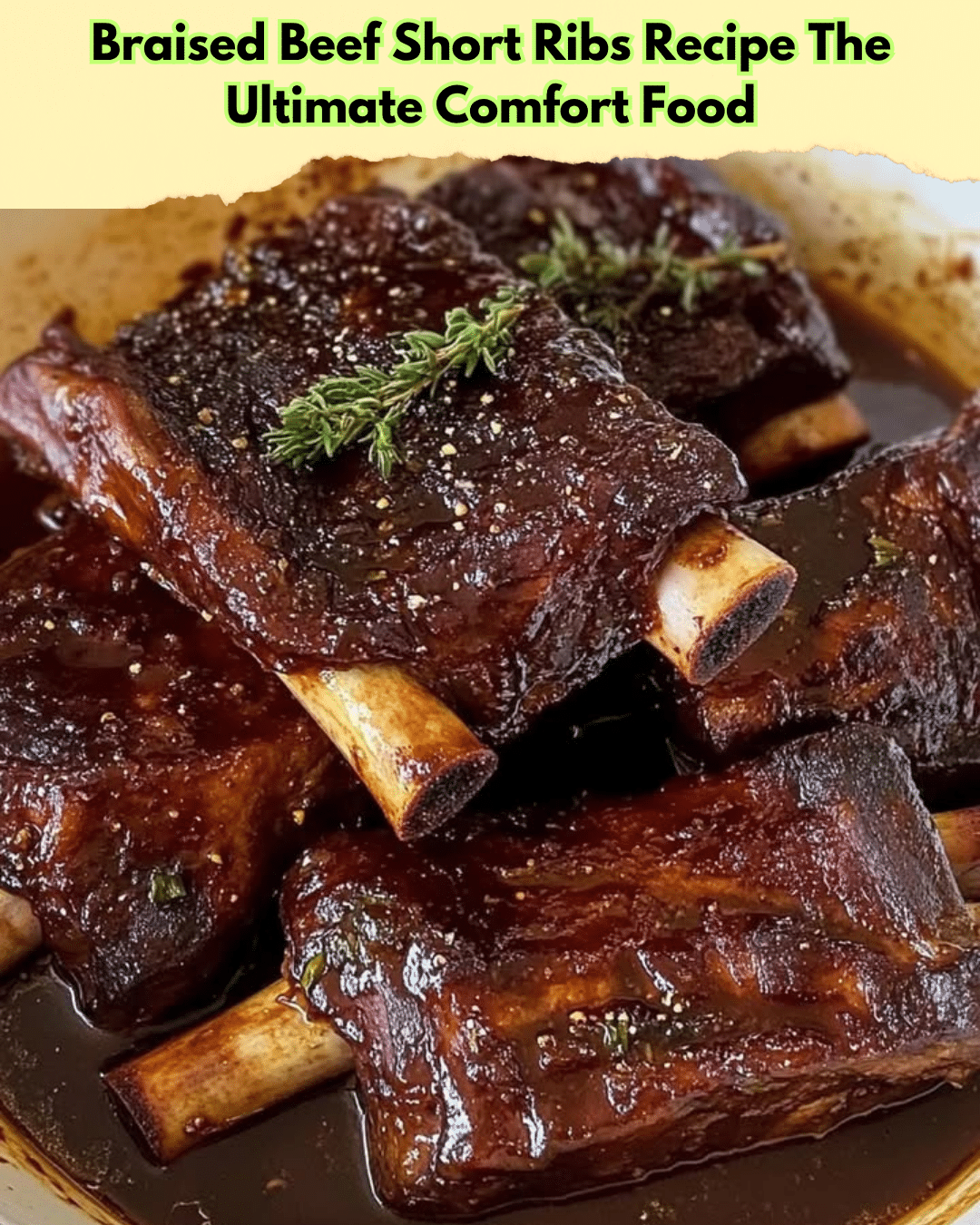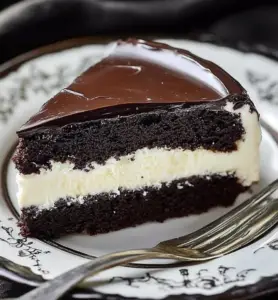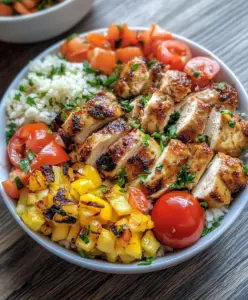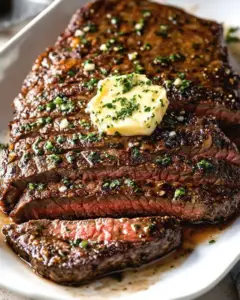Braised Beef Short Ribs Recipe: A Rich and Savory Delight
Braising beef short ribs transforms them into a succulent and intensely flavorful dish that is perfect for any special occasion or a cozy dinner at home. When cooked slowly, these ribs become fall-apart tender, immersing your senses in rich aromas and deep, robust flavors. Accompanied by a rich gravy imbued with herbs and wine, braised beef short ribs are sure to impress your guests and family alike. This recipe guides you through each step to create this exquisite, mouth-wateringly delicious meal.
Quick Recipe Highlights
- Flavor Profile: These braised beef short ribs offer an intensely rich and savory taste, with hints of red wine and aromatic herbs weaving through the layers of slow-cooked beef.
- Texture: Expect a mesmerizingly tender and juicy texture, as the slow cooking method melts away connective tissues and fuses flavors beautifully.
- Aroma: Inviting notes of garlic, rosemary, and beefy goodness will permeate your kitchen, providing a truly tantalizing experience.
- Visual Appeal: Serve up perfectly braised beef short ribs with a glossy, deep-brown color contrasted by fresh herbs for garnish, delivering a culinary masterpiece that is as visually striking as it is tasty.
- Skill Level Needed: This recipe requires an intermediate level of culinary expertise, particularly in browning meat and regulating low and slow heat.
- Special Equipment: A Dutch oven is ideal for evenly distributing heat and developing the rich flavors needed, though a heavy pot with a lid can suffice.
Recipe Overview
- Difficulty Level: While this recipe requires some culinary experience, such as properly browning meat and deglazing, patience is the key skill necessary to achieve perfection.
- Category: This dish fits beautifully into the main course category, perfect for family gatherings, dinner parties, or special occasions.
- Cuisine: Influenced by French cooking techniques, this dish is a showcase of the art of braising—a testament to European culinary tradition.
- Cost: While beef short ribs may be on the pricier side, the investment is justified by the hearty servings and exquisite flavors.
- Season: Ideal for fall and winter months when the desire for comforting and hearty meals is at its peak, bringing warmth to any occasion.
- Occasion: Special occasions, holiday gatherings, or even a weekend dinner party are perfect for serving this luxurious, hearty dish.
Why You’ll Love This Recipe
The rich taste and luxurious texture of braised beef short ribs will have everyone craving more, as the dish presents a perfect harmony between savory beef and subtle herb hints. The simplicity of preparation, despite its impressive results, makes it an appealing option for home chefs. Nutritionally, this dish provides a hearty source of protein as well as essential vitamins and minerals from the accompanying vegetables and herbs. Preparing this dish provides an opportunity to showcase your culinary skills, as no one can resist the tender allure of perfectly braised beef. The cost-effectiveness of this meal, given its few components but vast flavor profile, makes it accessible and rewarding.
Historical Background and Cultural Significance
With roots steeped in French gastronomy, the technique of braising meats stands out as a hallmark of traditional European cooking. This method was historically used to tenderize tougher cuts through slow, moist cooking. Culturally, braised beef short ribs have found a place in various cuisines, appreciated as a delicate yet hearty meal that pairs wonderfully with wine. Over the years, regional variations have added spices and flavors unique to their culinary heritages, which only enhances the love and renown of this dish.
Ingredient Deep Dive
Beef short ribs: These hearty cuts of meat, hailing from the chuck section, are prized for their rich marbling and flavor. Rich in protein and crucial minerals like iron, selecting ribs with good marbling is essential for an excellent braising outcome. Store them refrigerated for freshness, or freeze longer-term. For different taste profiles, consider substituting with another braising cut like brisket or chuck.
Red wine: Integral to the development of flavor in our dish, red wine adds depth and a silky note to the broth. A dry variety such as Cabernet or Merlot works best here. To keep leftovers fresh, transfer the wine to a smaller glass bottle to minimize air exposure.
Common Mistakes to Avoid
- Neglecting to brown the ribs thoroughly. This results in less depth of flavor, so ensure a caramelized crust forms on each side before proceeding.
- Skipping the deglazing step. This vital stage lifts flavorful browned bits from the pot, crucial for a robust sauce.
- Using a suboptimal pot, such as thin or large, which may lead to uneven heat distribution and longer cooking time.
- Adding vegetables at the wrong time—rushing this will lead to overly soft veggies that lack texture.
- Not allowing sufficient time for braising. Short ribs need time to break down properly, transforming into that desired luscious texture.
- Cooling the dish prematurely. Let it sit to enhance flavors further before serving.
- Skipping the rest before serving. Resting after cooking helps concentrate flavors and makes carving easier.
- Neglecting to taste and adjust seasoning at the end of cooking. This might make the dish under-seasoned or overpowered by single flavors.
Essential Techniques
Browning the beef short ribs is essential because it creates a rich, flavorful base for the dish. For mastering this technique, ensure your pan is hot, and avoid overcrowding the meat. Common pitfalls include moving the ribs too soon, which prevents a proper sear. Look for a deep brown crust indicating flavors have developed successfully, then remove and proceed to the next step.
Pro Tips for Perfect Braised Beef Short Ribs
Allow the ribs to sit at room temperature before browning to ensure even cooking. A generous seasoning of salt and pepper on both sides is essential for robust flavor absorption. Let the sauce cool slightly to enable easy skimming off of excess fat and to intensify flavors. When reheating leftovers, add a splash of broth or wine to refresh the exquisite sauce consistency. Always use fresh herbs for garnishing as they amplify the aroma and aesthetic appeal of your finished dish intriguingly. Finally, resting once cooked ensures juices redistribute evenly, enhancing the tenderness of your meat.
Variations and Adaptations
In exploring regional variations, consider a Southwest twist by incorporating smoked paprika and chipotles. Seasonal adaptations might introduce root vegetables like parsnips in winter. For dietary modifications, use lower sodium options for health-conscious choices. Flavor variations include adding a hint of orange peel for a refreshing edge. Modify textures by shredding the beef and serving as a sandwich filling. Present alternatively as part of a tapas platter for an avant-garde approach.
Serving and Presentation Guide
For plating, arrange the ribs on a wide-mouthed plate to showcase their splendor, accenting with snipped herbs for vibrant color. Garnishing with a sprinkle of freshly cracked pepper or crisp onion strings provides an inviting texture contrast. Traditionally, pair with mashed potatoes or polenta; for a modern take, a bed of risotto works beautifully. Serve warm to preserve the tenderness and watchful of portion control—each rib packs immense richness.
Wine and Beverage Pairing
Selecting wine pairings that complement, like a full-bodied Cabernet Sauvignon, accentuates the dish’s inherent flavors. Non-alcoholic options such as a rich mushroom broth deliver umami harmony. Freshly brewed herbal teas or strong black coffee provide subtle alternatives round off the experience robustly. Serving wines slightly cooler than room temperature preserves their refined complexity and balance.
Storage and Shelf Life
For optimal storage, refrigerate the ribs in an airtight container, where they can last up to three days. Freezing in portions is effective for extending shelf life to several months. Key signs of spoilage include an off-smell or discoloration. After storing, always reheat gently to preserve tenderness, and ensure internal temperature reaches at least 165°F to ensure safety.
Make Ahead Strategies
Crafting the ribs a day ahead allows the flavors to meld beautifully. Store covered with sauce to avoid drying out. Consider flash-freezing for convenient access later. Reheat the dish gently, adding during warm-up any fresh element such as herbs or a splash of stock to rejuvenate the flavors. Such preparation ensures that any hosting duties appear effortless while maintaining quality.
Scaling Instructions
When halving the recipe, adjust the cooking vessel size to avoid excessive liquid evaporation. Doubling or tripling requires a vigilant watch on pot space and heat distribution to maintain the correct braising environment. Equipment adjustments may necessitate scaling pans or using multiple dishes. Timing concerns are best managed by extending the searing and braising time proportionally while observing doneness visually.
Nutritional Deep Dive
A typical serving offers significant protein intake, fulfilling daily requirements and supporting muscle maintenance. While higher in calories due to the beef’s richness, balance with healthy green sides enhances micronutrient diversity. Ensure moderate portion sizes to enjoy indulgently while adhering to dietary balance goals. For those managing weight, consider incorporating leaner side options to offset the dish’s hearty nature.
Dietary Adaptations
For gluten-free needs, ensure wine selection is free of wheat-based ingredients. A dairy-free version omits any butter in favor of olive oil without sacrificing richness. Paleo enthusiasts can maintain the spirit of the dish by using pure beef stock and red wine without additives. Finally, a low-FODMAP adaptation involves using garlic-infused oils rather than whole cloves, preserving flavor delightfully.
Troubleshooting Guide
To resolve texture issues such as toughness, ensure ribs braise until fork-tender. Correct an overpowering flavor by balancing sauce with acid like a splash of vinegar. Equipment failures, like uneven heat, necessitate repositioning or micromanagement for even cooking. If ingredient swaps yield unsatisfactory results, incrementally test flavors during trials. Timing concerns such as overcooking can be managed through frequent checks for doneness well before finish.
Recipe Success Stories
Many readers have triumphantly shared their adaptation stories, incorporating regional spices for a personal touch. A multitude of families have enjoyed successful gatherings centered around this recipe, noting the ease of preparation despite its gourmet appearance. Communities have highlighted the social component of preparing a dish like this together, with children learning praises or older generations imparting tips—a culinary journey benefitting experienced cooks and novices.
Frequently Asked Questions
- Q: Can I use different cuts of meat?
A: While beef short ribs are ideal, chuck or brisket make viable substitutes. - Q: What wine should I select?
A: Opt for a dry red wine like Cabernet Sauvignon, adding depth without overwhelming the dish. - Q: How do I thicken the sauce?
A: Let the sauce reduce naturally, or mix in a cornstarch slurry until desired consistency. - Q: Can I cook this in a slow cooker?
A: Yes, simply brown and deglaze as directed, then transfer the mix to the slow cooker to continue as usual. - Q: What are good side dishes?
A: Mashed potatoes, polenta, and stewed vegetables are all fantastic side pairings. - Q: Is there a vegetarian option?
A: Use similar braising techniques with root vegetables like carrots or cauliflower instead. - Q: How should I reheat leftovers?
A: Gently warm the ribs with a little extra stock to prevent drying. - Q: How can I present this dish fancily?
A: Garnish with herbs and pair with elegant side dishes for sleek presentation. - Q: Can I marinate overnight?
A: You can marinate, but it’s not necessary as the braising process ensures flavor infusion. - Q: What’s the best pot to use?
A: A Dutch oven works best, but any heavy-lidded pot is suitable.
Additional Resources
Enhance your culinary journey with related recipes that blend with short ribs, like complementary sides and wine-braised dishes. Delve into special technique guides for mastering braising across varied dishes and meats. Expand your knowledge on prime beef cuts to make informed choices. Seasonal variations can inspire adaptations for diverse cultural palates, keeping your cooking fresh and exciting.
Print
Braised Beef Short Ribs
Description
A delicious and hearty dish featuring tender beef short ribs slowly braised in a rich sauce.
Ingredients
For the Crust:
- 2 lbs beef short ribs
- 2 cups beef stock
- 1 cup red wine
- 1 onion, chopped
- 4 cloves garlic, minced
- 2 tablespoons tomato paste
- 1 tablespoon olive oil
- Salt and pepper to taste
- Fresh rosemary sprigs
Instructions
1. Prepare the Crust:
- Season the short ribs with salt and pepper. In a large pot, heat olive oil over medium-high heat and sear the ribs until browned on all sides. Remove from pot and set aside.
- In the same pot, add the onion and garlic, and sauté until the onion is translucent. Stir in tomato paste and cook for another minute.
- Deglaze the pot with red wine, scraping up any browned bits from the bottom. Return the ribs to the pot, pour in the beef stock, and add rosemary sprigs. Bring to a boil, then reduce heat, cover, and let simmer for 2.5 to 3 hours until ribs are tender.
Notes
You can customize the seasonings to taste.




